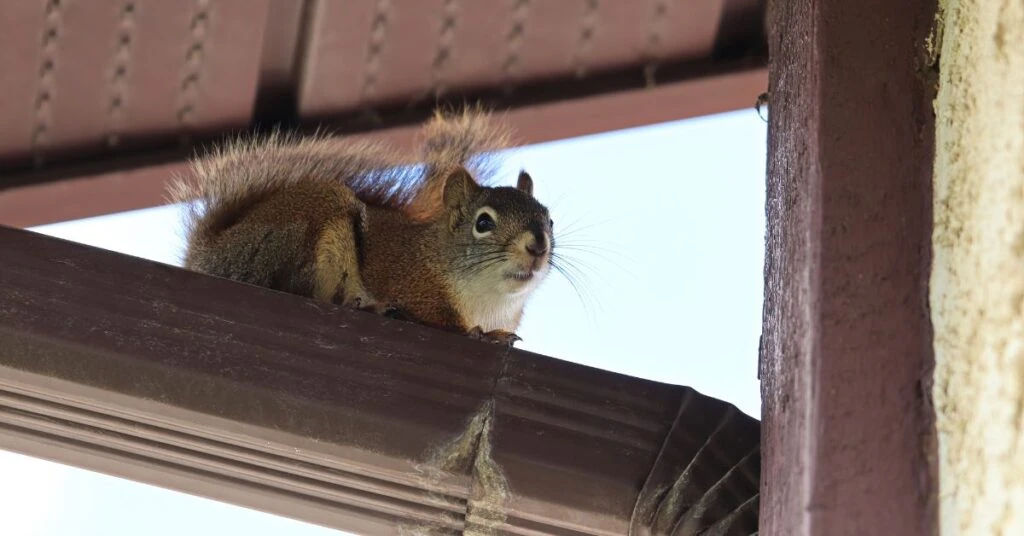Identifying Signs of Squirrels In Your House

Imagine you’re enjoying a quiet evening at home and suddenly hear a scuffling noise above your head. It might be a case of squirrels in your house. These agile creatures are known for finding their way into cozy spaces like your attic or walls. Recognizing the early signs of squirrels in your home is crucial for timely and effective removal.
Unmistakable Signs That Squirrels Are In Your Home
Wondering if those scampering sounds mean you have squirrels in your attic or walls? It’s crucial to spot the telltale signs early. Here are some unmistakable signs to watch out for, indicating that squirrels have turned parts of your house into their new playground.
Detecting Squirrel Activity
Squirrels in the attic can be quite noisy, making their presence hard to ignore. Listen for sounds like scratching, scurrying, or gnawing, especially during dawn or dusk. The noise level is a good indicator, as squirrels tend to be louder than smaller rodents.
Visual Signs: Droppings and Nesting Materials
Finding droppings or nesting materials in your attic can confirm suspicions of squirrels in your house. Look for small, oblong droppings and signs of nesting, such as torn insulation or gathered leaves and twigs, typical of squirrels in the attic.
Damage to the Home
Squirrels can cause significant damage to your house. Look for chewed electrical wires, holes or gnawed marks in the walls or roof, and damaged insulation. Such destruction is a nuisance and can lead to more severe issues, signaling the need to remove squirrels from the attic.
Changes in Pet Behavior
Your pets may alert you to squirrels in your home. If your pets are unusually interested in the walls or ceiling, it might be because they hear or smell squirrels in the walls.
Unpleasant Odors and Stains
A less obvious indication of squirrels in your house is the presence of foul smells or stains. These can result from squirrel droppings, urine, or, unfortunately, deceased animals in the walls or attic.
Taking Action Against Squirrels In Your Home
So, you’ve found signs of squirrels in your house, and now it’s time to act. But what’s the best way to handle these furry invaders, especially if they’re cozying up in your attic or walls? Here’s how to proceed safely and effectively, including when to call professionals to remove squirrels from your attic.
Confirming a Squirrel Presence
To be sure you’re dealing with squirrels, look for the above signs. Inspecting your attic and listening for distinct sounds can help confirm if you have squirrels in your house.
Seeking Professional Squirrel Removal Services
Once you’ve identified a squirrel problem, particularly squirrels in the attic or walls, it’s essential to seek professional help. 707 Pest Solutions specializes in safely and humanely removing squirrels from homes, ensuring that your living space is returned to its peaceful state.
Contact 707 Pest Solutions For Help With Squirrels In Your Home
Don’t let the sound of squirrels in your attic become a permanent background noise in your home. Allowing squirrels to live in your home can lead to extensive structural and insulation damage. If you suspect squirrels in your house, whether in the attic or walls, contact 707 Pest Solutions for expert assistance. Our team is ready to help you safely remove squirrels from your attic and ensure they don’t return.
FAQ About Squirrels In Your Home
Squirrels usually enter houses in search of shelter, warmth, and food. Attics and walls provide a cozy environment, especially during colder months or breeding seasons.
Several factors can attract squirrels to your house, including accessible food sources (like bird feeders or pet food), overhanging branches that provide easy access, and openings that allow entry into attics or walls.
Signs of a squirrel infestation include noises like scratching and scampering in the attic or walls, squirrel droppings, chewed wires or insulation, and visible entry points in the exterior of your house.
To get rid of squirrels quickly, seal all entry points, remove food sources, and use humane traps. For severe infestations, contacting professional wildlife removal services is the most effective and safe approach.
Squirrels dislike strong smells like peppermint, garlic, and white vinegar. Using these scents in areas where squirrels are active can deter them. They also avoid areas with no easy escape routes.
Squirrels can break into houses if they find vulnerabilities like loose siding, damaged roof shingles, or uncapped chimneys, using these as entry points to nest, especially in attics.
Squirrels typically don’t dig into houses, but they can exploit existing holes or weak spots in the exterior to gain entry. They are skilled climbers and often enter homes from the roof or upper levels.
Yes, squirrels can chew into your house. They have strong teeth that can gnaw through materials like wood, plastic, and even soft metals, which they can use to create or enlarge entry points.
In houses, squirrels often hide in attics, wall cavities, between floors, and even in basements or crawl spaces. They look for quiet, undisturbed areas to build nests.
